English Medium
Academic Year: 2016-2017
Date & Time: 21st March 2017, 12:30 pm
Duration: 3h
Advertisements
Write the molecular formula of first two members of homologous series having functional group -Cl.
Chapter: [0.04] Carbon and its Compounds
Name the method by which Spirogyra reproduces under favourable conditions. Is this method sexual or asexual?
Chapter: [0.07] How do Organisms Reproduce?
An object is placed at a distance of 30 cm in front of a convex mirror of focal length 15 cm. Write four characteristics of the image formed by the mirror.
Chapter: [0.09] Light - Reflection and Refraction
What is meant by "sustainable management"?
Chapter: [0.16] Sustainable Management of Natural Resources
Out of the two-reuse and recycle-which, in your opinion, is better to practise? Give reason.
Chapter: [0.16] Sustainable Management of Natural Resources
Management of forest and wild life resources is a very challenging task. Why? Give any two reasons.
Chapter: [0.16] Sustainable Management of Natural Resources
Two carbon compounds X and Y have the molecular formula C4H8 and C5H12 respectively. Which one of these is most likely to show addition reaction? Justify your answer. Also give the chemical equation to explain the process of addition in this case.
Chapter:
Complete the following chemical equations:CH3COOC2H5+NaOH→
Chapter: [0.04] Carbon and its Compounds
Complete the following chemical equations :CH3COOH+NaOH→
Chapter: [0.04] Carbon and its Compounds
Complete the following chemical equations:
C2H5OH+CH3COOH`("conc."H_2SO_4)/`>
Chapter: [0.04] Carbon and its Compounds
Write the names given to the vertical columns and horizontal rows in the Modern Periodic Table. How does the metallic character of elements vary on moving down a vertical column? How does the size of atomic radius vary on moving left to right in a horizontal row? Give reason in support of your answer in the above two cases.
Chapter: [0.05] Periodic Classification of Elements
An element P (atomic number 20) reacts with an element Q (atomic number 17) to form a compound. Answer the following questions giving reason:
Write the position of P and Q in the Modern Periodic Table and the molecular formula of the compound formed when P reacts with Q.
Chapter: [0.05] Periodic Classification of Elements
What happens when a Planaria gets cut into two pieces?
Chapter: [0.07] How do Organisms Reproduce?
What happens when Bryophyllum leaf falls on the wet soil?
Chapter: [0.07] How do Organisms Reproduce?
What happens when On maturation sporangia of Rhizopus bursts?
Chapter: [0.07] How do Organisms Reproduce?
State the basic requirement for sexual reproduction?
Chapter: [0.07] How do Organisms Reproduce?
Write the importance of sexual reproduction in nature.
Chapter: [0.07] How do Organisms Reproduce?
Advertisements
State the changes that take place in the uterus when Implantation of embryo has occurred
Chapter: [0.07] How do Organisms Reproduce?
State the changes that take place in the uterus when Female gamete/egg is not fertilised
Chapter: [0.07] How do Organisms Reproduce?
List three distinguishing features, in tabular form, between acquired traits and the inherited traits.
Chapter: [0.08] Heredity
Explain with an example for the given, how the following provides evidence in favor of evolution in organisms :
Homologous organs
Chapter: [0.08] Heredity
Explain with an example for the given, how the following provides evidence in favor of evolution in organisms :
Analogous organs
Chapter: [0.08] Heredity
Explain with an example for the given, how the following provides evidence in favor of evolution in organisms :
Fossils
Chapter: [0.08] Heredity
An object 4 cm in height, is placed at 15 cm in front of a concave mirror of focal length 10 cm. At what distance from the mirror should a screen be placed to obtain a sharp image of the object. Calculate the height of the image.
Chapter: [0.09] Light - Reflection and Refraction
Due to gradual weakening of ciliary muscles and diminishing flexibility of the eye lens a certain defect of vision arises. Write the name of this defect. Name the type of lens required by such persons to improve the vision. Explain the structure and function of such a lens.
Chapter: [0.09] Light - Reflection and Refraction
You have been selected to talk on 'ozone layer and its protection" in the school assembly on 'Environment Day.'
(a) Why should ozone layer be protected to save the environment?
(b) List any two ways that you would stress in your talk to bring in awareness amongst your fellow friends that would also help in protection of ozone layer as well as the environment.
Chapter: [0.13] Our Environment
Both soap and detergent are some type of salts. What is the difference between them?
Chapter: [0.04] Carbon and its Compounds
Describe in brief the cleansing action of soap.
Chapter: [0.04] Carbon and its Compounds
Why do soaps not form lather in hard water?
Chapter: [0.04] Carbon and its Compounds
List two problems that arise due to the use of detergents instead of soaps.
Chapter: [0.04] Carbon and its Compounds
Name the human male reproductive organ that produces sperms and also secretes a hormone. Write the functions of the secreted hormone.
Chapter: [0.07] How do Organisms Reproduce?
Name the parts of the human female reproductive system where
i. fertilisation takes place
ii. implantation of the fertilised egg occurs
Chapter: [0.07] How do Organisms Reproduce?
Explain how the embryo gets nourishment inside the mother’s body.
Chapter: [0.07] How do Organisms Reproduce?
How did Mendel interpret his results to show that traits may be dominant or recessive? Describe briefly.
Chapter: [0.08] Heredity
How do Mendel's experiment show that traits are inherited independently?
Chapter: [0.08] Heredity
Analyse the following observation table showing variation of image distance (v) with object distance (u) in case of a convex lens and answer the questions that follow, without doing any calculations:
| S. No. | Object distance u(cm) | Image distance v(cm) |
| 1 | −90 | +18 |
| 2 | −60 | +20 |
| 3 | −30 | +30 |
| 4 | −20 | +60 |
| 5 | −18 | +90 |
| 6 | −10 | +100 |
(a) What is the focal length of the convex lens? Give reason in support of your answer.
(b) Write the serial number of that observation which is not correct. How did you arrive at this conclusion?
(c) Take an appropriate scale to draw ray diagram for the observation at S. No. 4 and find the approximate value of magnification.
Chapter: [0.09] Light - Reflection and Refraction
To construct a ray diagram we use two rays which are so chosen that it is easy to know their directions after reflection from the mirror. List two such rays and state the path of these rays after reflection in case of concave mirrors. Use these two rays and draw ray diagram to locate the image of an object placed between pole and focus of a concave mirror.
Chapter: [0.09] Light - Reflection and Refraction
A concave mirror produces three times magnified image on a screen. If the object is placed 20 cm in front of the mirror, how far is the screen from the object.
Chapter: [0.09] Light - Reflection and Refraction
Draw a ray diagram to explain the term angle of deviation.
Chapter: [0.1] The Human Eye and the Colourful World
Why do the component colours of incident white light split into a spectrum while passing through a glass prism, explain
Chapter: [0.1] The Human Eye and the Colourful World
What is a rainbow? Draw a labelled diagram to show the formation of a rainbow.
Chapter: [0.1] The Human Eye and the Colourful World
Advertisements
You have four test tubes, A, B, C and D containing sodium carbonate, sodium chloride, lime water and blue litmus solutions respectively. Out of these the material of which test tube/ test tubes would be suitable for the correct test of acetic/ethanoic acid?
(a) only A
(b) A and B
(c) B and C
(d) A and D
Chapter: [0.04] Carbon and its Compounds
For preparing soap in the laboratory we require an oil and a base. Which of the following combinations of an oil and a base would be best suited for the preparation of soap?
(a) Castor oil and calcium hydroxide
(b) Turpentine oil and sodium hydroxide
(c) Castor oil and sodium hydroxide
(d) Mustard oil and calcium hydroxide
Chapter: [0.04] Carbon and its Compounds
A student took four test tubes P, Q, R and S and filled about 8 mL of distilled water in each. After that he dissolved an equal amount of Na2SO4 in P, K2SO4 in Q, CaSO4 in R and MgSO4 in S. On adding an equal amount of soap solution and shaking each test tube well, a good amount of lather will be obtained in the test tubes:
(a) P and Q
(b) P and R
(c) P, Q and S
(d) Q, R and S
Chapter: [0.04] Carbon and its Compounds
A student while observing an embryo of a gram seed listed various parts of the embryo as listed below :
Testa, Micropyle, Cotyledon, Tegmen, Plumule, Radicle. On examining the list the teacher commented that only three parts are correct. Select these three correct parts :
(a) Cotyledon, Testa, Plumule
(b) Cotyledon, Plumule, Radicle
(c) Cotyledon, Tegmen, Radicle
(d) Cotyledon, Micropyle, Plumule
Chapter: [0.07] How do Organisms Reproduce?
Which of the following is a correct set of homologous organs?
(a) Forelimbs of frog, bird and lizard
(b) Spine of cactus and thorn of bougainvillea
(c) Wings of bat and wings of butterfly
(d) Wings of a bird and wings of a bat
Chapter: [0.08] Heredity
Three students A, B and C focussed a distant building on a screen with the help of a concave mirror. To determine focal length of the concave mirror they measured the distances as given below:
Student A : From mirror to the screen
Student B : From building to the screen
Student C : From building to the mirror
Who measured the focal length correctly ;
(a) Only A
(b) Only B
(c) A and B
(d) B and C
Chapter: [0.09] Light - Reflection and Refraction
If you focus the image of a distant object, whose shape is given below, on a screen using a convex lens, the shape of the image of this object on the screen would be:
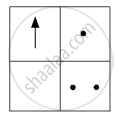
(a)
(b)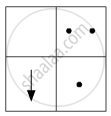
(c)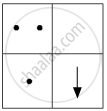
(d)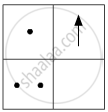
Chapter: [0.09] Light - Reflection and Refraction
In the following diagram the correctly marked angles are :
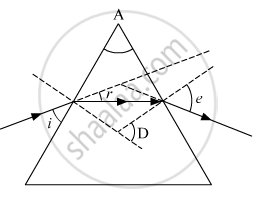
(a) ∠A and ∠e
(b) ∠i, ∠A and ∠D
(c) ∠A ∠r and ∠e
(b) ∠A ∠r and ∠D
Chapter: [0.1] The Human Eye and the Colourful World
The correct sequencing of angle of incidence, angle of emergence, angle of refraction and lateral displacement shown in the following diagram by digits 1, 2, 3 and 4 is:
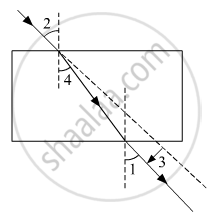
(a) 2, 4, 1, 3
(b) 2, 1, 4, 3
(c) 1, 2, 4, 3
(d) 2, 1, 3, 4
Chapter: [0.1] The Human Eye and the Colourful World
A gas is liberated immediately with a brisk effervescence, when you add acetic acid to sodium hydrogen carbonate powder in a test tube. Name the gas and describe the test that confirms the identity of the gas.
Chapter: [0.04] Carbon and its Compounds
Name the type of asexual reproduction in which two individuals are formed from a single parent and the parental identity is lost. Draw the initial and the final stages of this type of reproduction. State the event with which this reproduction starts.
Chapter: [0.07] How do Organisms Reproduce?
A student places a candle flame at a distance of about 60 cm from a convex lens of focal length 10 cm and focuses the image of the flame on a screen. After that he gradually moves the flame towards the lens and each time focuses the image on the screen.
(a) In which direction-toward or away from the lens, does he move the screen to focus the image?
(b) How does the size of the image change?
(c) How does the intensity of the image change as the flame moves towards the lens?
(d) Approximately for what distance between the flame and the lens, the image formed on the screen is inverted and of the same size?
Chapter: [0.09] Light - Reflection and Refraction
Other Solutions
Submit Question Paper
Help us maintain new question papers on Shaalaa.com, so we can continue to help studentsonly jpg, png and pdf files
CBSE previous year question papers Class 10 Science with solutions 2016 - 2017
Previous year Question paper for CBSE Class 10 Science-2017 is solved by experts. Solved question papers gives you the chance to check yourself after your mock test.
By referring the question paper Solutions for Science, you can scale your preparation level and work on your weak areas. It will also help the candidates in developing the time-management skills. Practice makes perfect, and there is no better way to practice than to attempt previous year question paper solutions of CBSE Class 10.
How CBSE Class 10 Question Paper solutions Help Students ?
• Question paper solutions for Science will helps students to prepare for exam.
• Question paper with answer will boost students confidence in exam time and also give you an idea About the important questions and topics to be prepared for the board exam.
• For finding solution of question papers no need to refer so multiple sources like textbook or guides.
